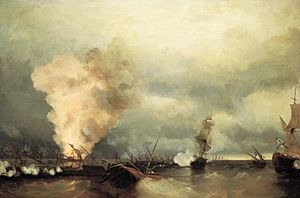Battle of Vyborg Bay (1790)
| Battle of Viborg Bay | |||||||
|---|---|---|---|---|---|---|---|
| Part of the Russo-Swedish War (1788–90) | |||||||
 Battle of Vyborg Bay, by Ivan Aivazovsky |
|||||||
|
|||||||
| Belligerents | |||||||
|
|
|
||||||
| Commanders and leaders | |||||||
| Vasili Chichagov |
Gustav III of Sweden Prince Karl, Duke of Södermanland |
||||||
| Strength | |||||||
| 29 ships of the line 72 galleys 11 frigates 20 additional galleys 8 additional archipelago frigates 52 additional galleys 21,000 sailors and soldiers |
21 ships of the line 13 frigates 366 smaller ships 3,000 guns 30,000 sailors and soldiers |
||||||
| Casualties and losses | |||||||
|
|
||||||
The Battle of Viborg Bay (in Swedish literature known as Viborgska gatloppet, "the Viborg gauntlet") was a naval battle fought between Russia and Sweden on July 4, 1790, during the Russo-Swedish War (1788-1790). The Swedish Navy suffered heavy losses, losing six ships of the line and four frigates, but Gustav III of Sweden eventually ensured a Swedish naval escape through a Russian naval blockade composed of units of the Baltic Fleet, commanded by Admiral Vasili Chichagov. The battle ranks among the world's largest historical naval battles and also among the most influential, as it introduced the naval battle concept of "firepower over mobility".
In 1790, King Gustav III of Sweden revived his plan for a landing close to St. Petersburg, this time near Viborg. But the plan foundered in a disastrous attack on the Russian fleet at the Battle of Reval on May 13. A further attack on the Russian fleet off Kronstadt at the beginning of June also failed and the Swedish high seas fleet and the "archipelago fleet" (skärgårdsflottan) both retired to Vyborg Bay.
The stage for the battle was set in the first week of June 1790. Northern white nights were nearly as light as the day and, to King Gustav's consternation, unfavourable southwesterly winds prevented the combined Swedish fleets of some 400 vessels from sailing southeast to Swedish-controlled Finnish waters. This allowed the Russian sailing battlefleet and coastal galley fleet to join forces.
King Gustav ordered a two-part Swedish naval force of 400 ships (with 3,000 guns and 30,000 sailor and soldiers) to anchor temporarily between the islands of Krysserort (Ristiniemi in Finnish), and Biskopsö (Severny Berezovy in Russian, Piisaari in Finnish) just inside the mouth of Bay of Viborg, Russia, in the Gulf of Finland. This strategic position placed the Swedish navy within striking distance of the Russian imperial capital, Saint Petersburg.
...
Wikipedia
